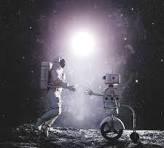NASA has been a pioneer in integrating Artificial Intelligence (AI) with robotics to enhance space exploration, planetary science, and mission autonomy. Here's an overview of how NASA uses AI in robotics:
Key Areas Where NASA Uses AI in Robotics
1. Autonomous Rovers
-
Mars Rovers (e.g., Perseverance, Curiosity) use AI for:
-
Navigation: Avoiding obstacles and plotting paths on Mars without constant human input.
-
Scientific Analysis: Choosing which rocks and terrain to study based on AI-assisted pattern recognition.
-
Self-diagnosis: Monitoring system health and reporting anomalies.
-
2. Robonauts & Humanoid Robots
-
Robonaut 2 (R2): A humanoid robot designed for tasks on the ISS.
-
Uses AI for fine motor skills and decision-making in semi-autonomous or remote-controlled operations.
-
-
Goal: Reduce astronaut workload and eventually perform EVA (extravehicular activity) tasks.
3. Astrobee Robots
-
Small, cube-shaped robots on the ISS.
-
Navigate autonomously using AI for mapping and localization.
-
Help astronauts with routine tasks and inventory management.
-
4. AI for Spacecraft Operations
-
NASA’s Deep Space Network (DSN) uses AI to manage communication with distant spacecraft.
-
Autonomous Navigation: For spacecraft far from Earth, like the Deep Space One mission.
5. Planetary Drones
-
Ingenuity Helicopter: AI-powered drone on Mars, assists Perseverance Rover.
-
Makes flight decisions autonomously in a harsh and unpredictable Martian environment.
-
6. Earth-Based Applications
-
AI-driven robots help in Earth analog missions (e.g., volcanic terrain, underwater exploration).
-
Assisting in disaster response with autonomous navigation and data collection.
Future Vision
NASA aims to develop:
-
Fully autonomous systems for Moon and Mars missions (Artemis & Mars Sample Return).
-
AI collaboration with astronauts for real-time problem-solving.
-
Robotic assistants that can handle emergencies or habitat maintenance without human presence

 SkillClick
SkillClick
